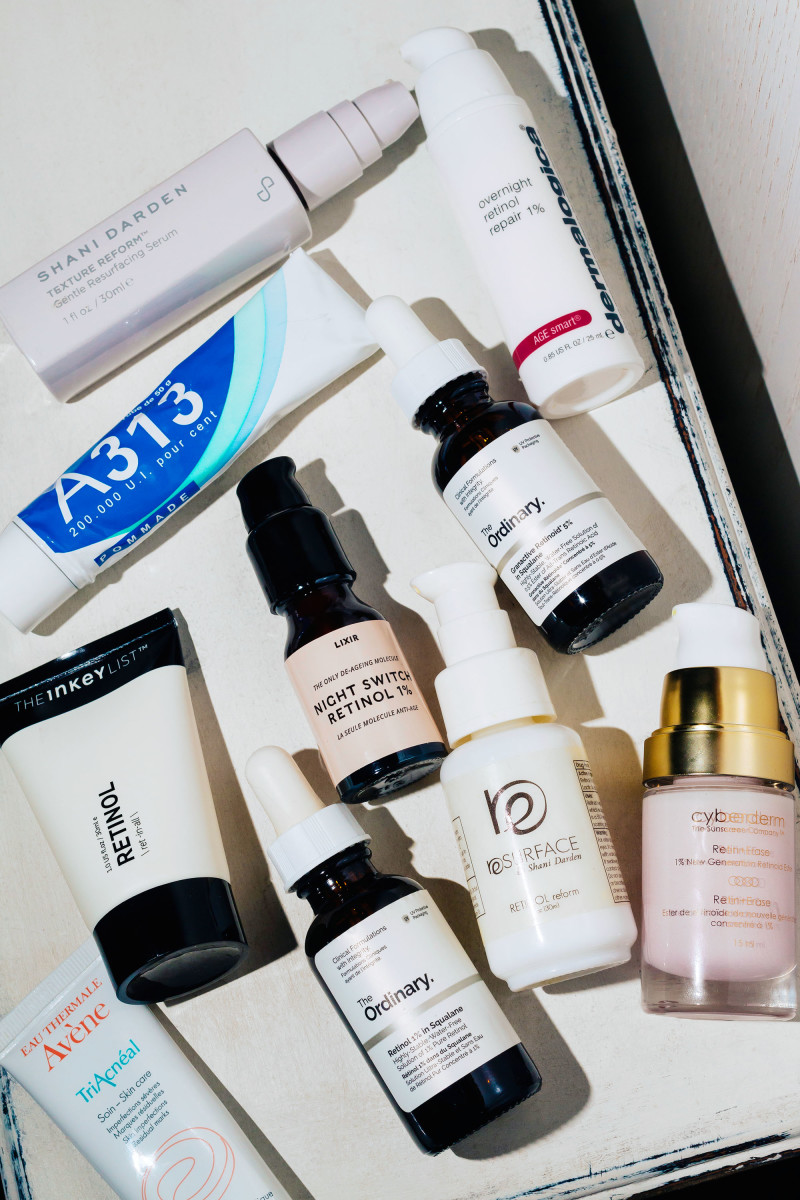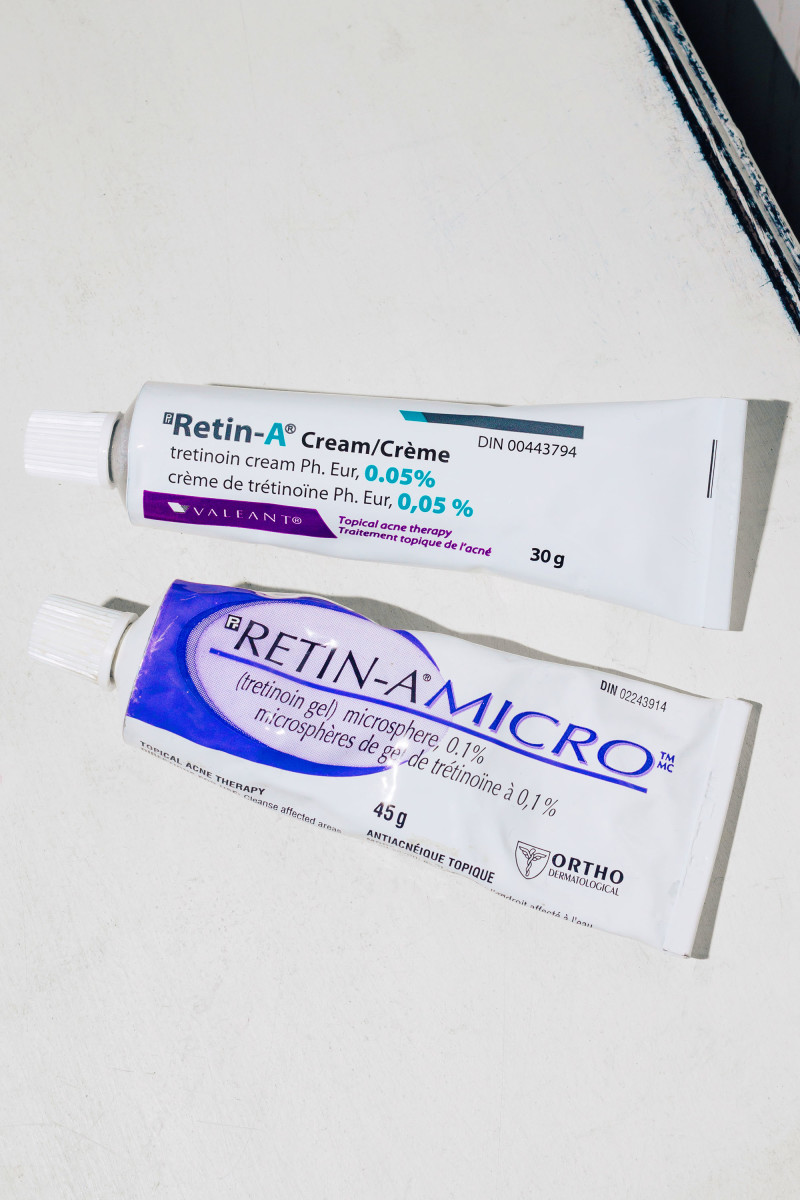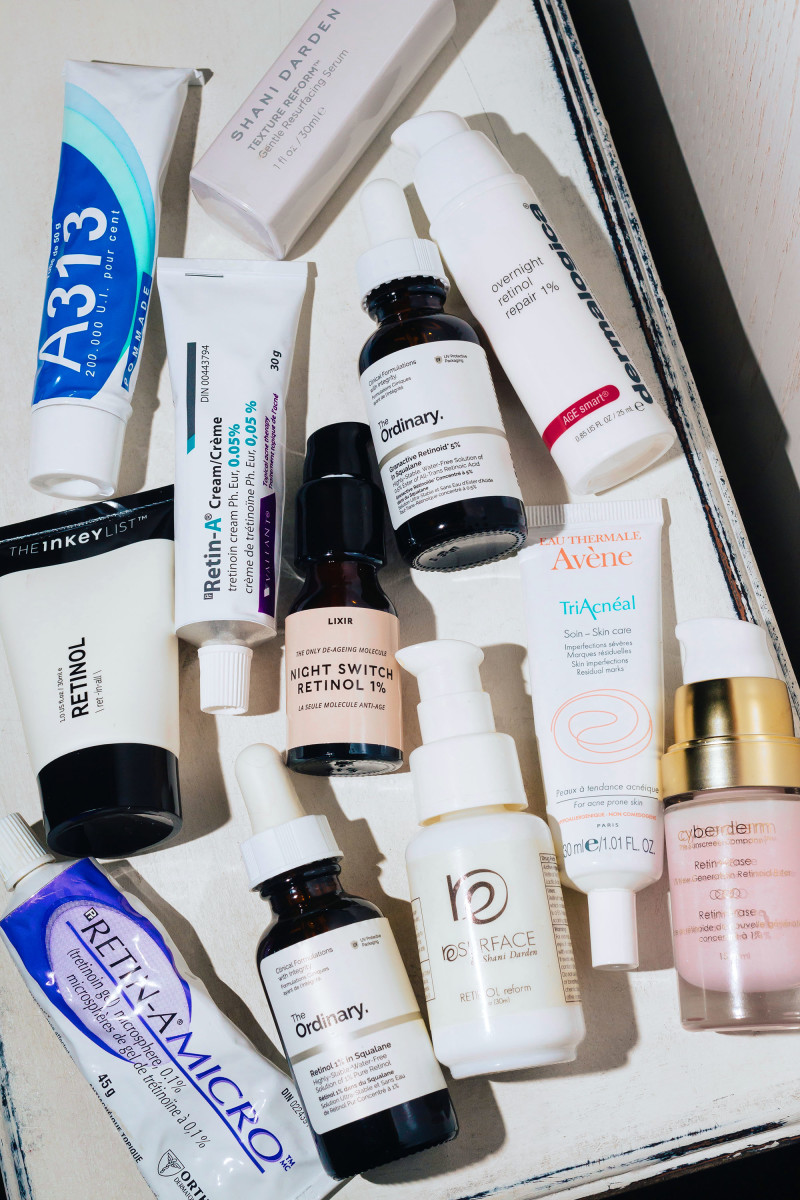Anyone dabbling with anti-aging skincare products is bound to hear about two active ingredients again and again:
Retinoid and retinol.
They sound similar, and if you guessed that they're both forms of vitamin A, you'd be right.
But is there actually a difference between them? And most importantly, what can they do for your skin?
In this tutorial, you will learn:
- What is a retinoid and what is retinol
- All the types of over-the-counter retinoids
- All the types of prescription retinoids
- Which skin concerns they're best for, plus my product suggestions
Plus, I've got a free cheat sheet for you to download at the end of this article!
Retinoid vs Retinol
The terms "retinoid" and "retinol" are often used interchangeably, but they're not quite the same thing.
Retinoid is an umbrella term for the entire FAMILY of vitamin A derivatives, including both over-the-counter products (which are the gentlest) and prescription treatments (which are the most potent). The different types of retinoids include:
- Retinol esters
- Retinol
- Retinaldehyde
- Retinoic acid esters
- Adapalene
- Tretinoin
- Tazarotene
- Trifarotene
- Isotretinoin
In general, the regular use of retinoids can give you improvements such as fewer fine lines and wrinkles, firmer skin, more even skin tone and fewer breakouts.
Retinol is one specific type of retinoid—the most common and proven retinoid sold over-the-counter. Dermatologists often refer to retinol as the "gold standard" anti-aging ingredient because not only is it widely available, it also has decades of research behind it to demonstrate its effectiveness.
So does that mean you should just stick with retinol? Or is it worth trying one of the other retinoids?
To answer that question, you need to understand how retinoids convert to active vitamin A!
The Retinoid Conversion Process
No matter which retinoid you choose, your skin can ONLY use the active form of vitamin A, retinoic acid.
Retinoic acid binds to the retinoid receptors in our bodies (of which there are three types), where it normalizes cellular renewal and cellular repair processes. This is how retinoids work their magic on lines, dark spots and more!
The strongest retinoids, including tretinoin and isotretinoin, are pure retinoic acid. So they are the most biologically active retinoids, and will start to change your skin right away (although the side effects can be significant). This is why retinoic acid treatments are available by prescription only.
Gentler, over-the-counter retinoids have to be converted into retinoic acid by the enzymes in our skin before we can actually get their benefits. This can happen in one, two or three steps.
- One step: Retinaldehyde is the direct precursor to retinoic acid.
- Two steps: Retinol first converts to retinaldehyde, and then from retinaldehyde into retinoic acid.
- Three steps: Retinol esters convert to retinol, then from retinol to retinaldehyde, and finally from retinaldehyde to retinoic acid.
The closer the compound to retinoic acid, the more readily it converts—and the more effective it becomes.
But keep in mind that the conversion rate can also vary depending on the individual (some people convert retinoids into retinoid acid more quickly than others!). Other factors include the concentration of the active ingredient and whether or not it has degraded (some retinoids are unstable).
Now, let's take a closer look at each type of retinoid and what it can do.
Types of Over-the-Counter Retinoids

Over-the-counter retinoids from Shani Darden, Dermalogica, The Ordinary, CyberDerm, Avène, The Inkey List, Lixirskin and A313.
Retinol Esters
Retinol esters are the mildest types of retinoids, because they need to be converted three times within our skin before they become active. This makes them a good choice for sensitive, reactive skin and anyone new to retinoids, as they are unlikely to cause any irritation.
But not all retinol esters are made equal. The most effective is retinyl propionate, which has been shown in higher concentrations to reduce wrinkles and pigmentation. Retinyl palmitate is your next best choice, with some benefits for photodamage and skin thickening (although it's worth noting Dr. Leslie Baumann believes it is "topically ineffective").
The other retinol esters—retinyl acetate and retinyl linoleate—are weaker and best used in combination with each other and/or stronger retinoids.
Products to try:
- Shani Darden Texture Reform (reviewed here) is a gentle retinyl palmitate serum made specifically for sensitive skin.
- Shani Darden Retinol Reform (reviewed here) is a cult-favourite serum with five percent each of retinyl propionate and lactic acid. (Confusingly, the website lists "retinol" as the active ingredient, but as per the box, it's actually retinyl propionate.)
- A313 Vitamin A Pommade (reviewed here) is another cult retinoid, an ointment with retinyl acetate, retinyl palmitate and retinyl propionate. (It's actually quite strong!)
- Vivant Skin Care Derm-A-Gel is a retinyl propionate serum that also has kojic acid, lactic acid and niacinamide.
- Joanna Vargas Daily Serum is a hydrating and gentle anti-aging serum with retinyl palmitate, hyaluronic acid and vitamins C and E.
Retinol
Retinol, the most popular over-the-counter retinoid, goes through two conversions before it becomes active. That means you're getting a more effective form of vitamin A than the retinol esters. In fact, retinol has been proven to induce similar skin changes as retinoic acid—it may just take a little longer to get there.
Research shows that retinol can significantly improve wrinkles, whether caused by sun damage or normal aging (see here, here and here, to name just a few studies). It can also help to fade pigmentation, improve skin elasticity and smooth rough skin texture.
The downside is that retinol can be drying and irritating for some people, although not as much as stronger retinoids like tretinoin. However, even sensitive skin can be trained to tolerate retinol, believes Dr. Dendy Engelman. (It's also worth noting that the inactive ingredients in a formula could be triggering irritation, not necessarily the retinol itself.)
Products to try:
Retinaldehyde
Retinaldehyde, also known as retinal, is directly converted into retinoic acid by our skin. So it works faster than retinol, and may even be more effective (it just doesn't have as much research behind it). Like we saw with retinol, retinaldehyde can also produce skin changes that are comparable to retinoic acid.
For example, retinaldehyde was proven to be just as effective as retinoic acid for treating sun damage, with fewer side effects. Other studies have shown that it improves skin thickness and elasticity, repairs UVA damage and (in conjunction with hyaluronic acid) reduces wrinkles, nasolabial folds and crow's feet. Retinaldehyde is also particularly effective for acne, since it is antibacterial and helps regulate skin cell shedding and turnover.
Similar to retinol, you can get some dryness and irritation from using retinaldehyde, but not on the same level as you would from a pure retinoic acid.
Products to try:
Retinoic Acid Esters
Retinoic acid esters are a new generation of retinoids that are cropping in more and more products. Although we don't have a lot of data on them yet, they show promise for being more active than retinol, without the irritation.
One type of retinoic acid ester is retinyl retinoate. It breaks down into both retinoic acid and retinol, making it active within one step (just like retinaldehyde), as well as more active later on, once the retinol is converted. So far, studies show that retinyl retinoate is more effective than retinol for treating wrinkles. It also works on mild to moderate acne by fighting bacteria and reducing sebum production.
The other type of retinoic acid ester is hydroxypinacolone retinoate (HPR), which you might be familiar with as "granactive retinoid" (a term popularized by The Ordinary). Granactive retinoid is simply a complex that includes HPR, the active, in a 1:10 ratio with a solvent, dimethyl isosorbide. So when you see a percentage of granactive retinoid being quoted, be aware that you need to divide by 10 to get the actual concentration of HPR.
Since HPR binds directly to retinoid receptors, its activity is similar to pure retinoic acid. But not only is it less irritating than tretinoin, it is also less irritating than even 0.5 percent retinol. Nearly all the research comes from the manufacturer, which found that HPR significantly reduces wrinkles, age spots and sun damage. Another study found it has greater levels of gene expression than retinol.
Note: HPR is available over-the-counter in the US, UK and Australia, but no longer sold in Canada, where it is now considered a drug.
Products to try:
Adapalene
Adapalene, which recently became available over-the-counter in the US, is a synthetic retinoid that selectively binds to some (but not all) of the retinoid receptors in our skin. That means it does not need to be converted to retinoic acid before it becomes active.
Its main claim to fame is treating acne. One of the biggest meta-analyses found that adapalene is more effective than tretinoin and better tolerated. It works by normalizing keratinization, reducing inflammation and inhibiting microcomedone formation. Adapalene has also been found to treat mild to moderate signs of photoaging, including wrinkles.
Although it's less irritating than tretinoin, adapalene can cause dryness, flakiness, redness and stinging, especially during the first few months of treatment.
Products to try:
Types of Prescription Retinoids
Adapalene
Adapalene is also a prescription medication. While the 0.1 percent formula is sold over-the-counter in the US, you'll need a prescription for the stronger 0.3 percent concentration. In the UK, Canada and Australia, all concentrations of adapalene are only available by prescription.
Again, adapalene only targets specific retinoid receptors, unlike tretinoin and isotretinoin. It is most effective as a treatment for acne, but can also help with wrinkles and sun damage. It is also associated with less irritation than tretinoin.
Tretinoin
Often known by the brand name Retin-A, tretinoin is pure retinoic acid. So it doesn't need to be converted when it comes in contact with your skin, and gets to work immediately.
Tretinoin has demonstrated a significant ability to reduce lines and wrinkles by restoring collagen formation and inhibiting collagen degradation. It also tightens loose skin, smooths rough skin, fades brown spots and melasma, and reduces sallowness. And it's not just effective for signs of aging. Tretinoin treats acne, too, because it slows down keratinization and allows sebum to flow without clogging. (Is there anything tretinoin can't do!?)
Unfortunately, there's a catch. Irritation, dryness, peeling, redness and even swelling are common side effects of tretinoin. There's also a risk that tretinoin-induced inflammation could lead to hyperpigmentation.
Tazarotene
Tazarotene is the strongest topical retinoid, and like adapalene, it is receptor-selective. In other words, it only binds to some of our retinoid receptors, where it becomes immediately active (no conversion steps necessary).
It is best-known as Tazorac, a prescription medication for psoriasis and acne. The jury's out on whether it is more effective than adapalene on acne (some studies say it's superior, others say it's comparable), but we do know it works better than tretinoin. In addition, it can reduce wrinkles, fade pigmentation, shrink pore size and thicken the epidermis.
Like the other prescription retinoids, tazarotene is associated with dryness, redness and irritation, particularly when beginning usage. Due to its potency, it tends to be more irritating than adapalene.
Trifarotene
Trifarotene is the newest retinoid on the block. It's different from adapalene and tazarotene because it targets just one retinoid receptor (the most common one found in our skin). As a result, it is gentler than the other prescription retinoids.
So far, it is being touted as a medication for acne. Research indicates that it reduces inflammatory acne lesions both on the face as well as the chest, shoulders and back.
Compared to tretinoin and even adapalene, it is not as irritating. So if you have sensitive skin and have had trouble tolerating prescription acne treatments, it's definitely worth a shot.
Isotretinoin
Isotretinoin, also known as Accutane, is a prescription retinoid that you take orally. Like topical tretinoin, it consists of pure retinoic acid.
Doctors prescribe isotretinoin to treat severe acne that has not responded to other medications. It works by dramatically reducing sebum production, slowing down skin cell shedding and making sebaceous ducts inhospitable to acne bacteria.
However, isotretinoin is linked to many serious side effects. Among them are cheilitis, tiredness, eczema, headaches, joint pain, bone disorders and anemia. Users are also at higher risk for depression, suicide and inflammatory bowel disease.
Conclusion + Free Cheat Sheet
Now you know the difference between retinoids and retinol, as well as ALL the different members of the retinoid family.
It's a lot to remember—which is why I created the Types of Retinoids Cheat Sheet. Just click below to download it so you don't forget any of the retinoids, and have a handy reference when checking your skincare ingredients lists. (It's FREE!)
Personally, I'm a big believer in over-the-counter retinoids, since research has shown you can get comparable results to prescription treatments, without all the irritation.
In my experience, it's definitely true. I've tried tretinoin in the past, but my skin is a lot happier with retinoids like A313 (reviewed here) and Shani Darden Retinol Reform (reviewed here). Even though they only contain retinol esters, the weakest types of retinoids, they make my skin clear, plump and even-toned—with none of the angry, flaky skin I always struggled with on Retin-A.
Let me know if you've tried a retinoid yet, and what it's done for your skin!
Shop Editor’s Picks
What's your favourite retinoid?
And what results have you noticed?
Retinoid vs Retinol: What’s the Difference (and How to Choose the Right One for Your Skin) syndicated from The Skincare Edit
October 15, 2019 at 12:31AM




No comments:
Post a Comment